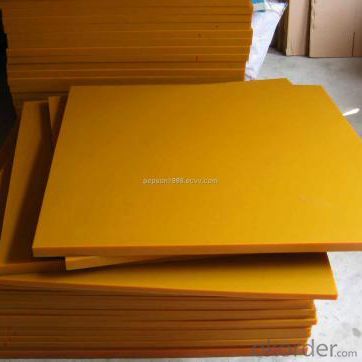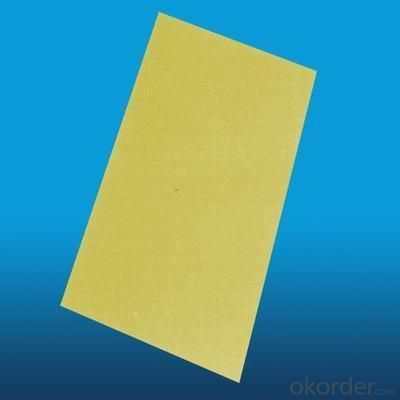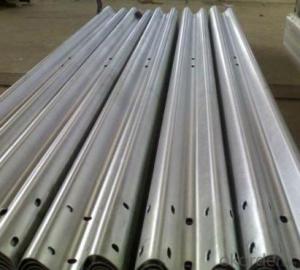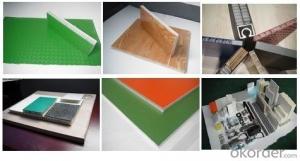FRP Roofing Panel - Corrugated Fiberglass Roof Panel FRP Sheet
- Loading Port:
- Tianjin
- Payment Terms:
- TT OR LC
- Min Order Qty:
- 300 m
- Supply Capability:
- 50000 m/month
OKorder Service Pledge
OKorder Financial Service
You Might Also Like
Specification
PRODUCT DESCRIPTION
FRP roofing sheet usually use a protecting facility in construction site,steel structured workshop and warehouse,canopy,packing sheds,corridors,studio light awning and greenhouse etc as the excellent light transmittance.FRP plane skylight is the more strengthened, safety, and more econimal greenhouse panel with the properties of waterproof,good light transmittance,heat insulation,strong impact resistant, withstand extreme temperature.
FEATURES
1.Light transmission
The light transmission of FRP roof Sheet is between 60-85%. Light through FRP corrugated Sheet scatters and is
mild. It will not form a light band so as to make the indoor brighter.
2.Weather resistance
The anti-aging film covering on the surface of FRP corrugated sheet improves its property of weather resistance.
The anti- ultraviolet adsorbing agent mixing in the raw materials absorbs 99.9% of ultraviolet ray of the visible
light transmitted through the FRP sheets.
3.Corrosion resistance
The products resist various acids, alkalis and peroxides, especially suitable for application in the coastal
areas and corrosive places.Temperature performance and insulation FRP roof Sheet is a kind of hot solid
high polymer materials. It is designed for normal use in temperatures - 40℃~120℃ .The coefficient of heat
conduction of FRP roof Sheet is only 1/4 of the glass.
SPECIFICATIONS
| Name: | Fibreglass Reinforced Polyester(FRP ) Sheet |
| Material: | Protective film, Unsaturated resin polyester, Fiberglass |
| Weight: | 1800g/2400g/2750g/3050g Square meter |
| Thickness: | 0.8~3.0mm |
| Length: | Customized |
| Temp: | used in -40°c to 140 °c |
| OEM: | Welcomed |
| Color: | Clear/Blue |
PICTURES



- Q: Are FRP roofing panels resistant to environmental pollutants or acid rain?
- Withstanding environmental pollutants and acid rain with great resilience, FRP roofing panels are manufactured using a composite material engineered to endure even the harshest weather conditions and chemical exposure without any degradation. The corrosion-resistant material utilized in these panels makes them an exceptional option for regions susceptible to acid rain or elevated levels of environmental pollutants. This exceptional resistance guarantees that the panels retain their structural integrity and aesthetic charm over extended periods, offering enduring safeguarding for buildings.
- Q: Can FRP roofing panels be used in high wind areas?
- FRP (Fiberglass Reinforced Plastic) roofing panels are capable of being utilized in areas with high wind. These panels possess a reputation for their exceptional strength and durability, rendering them suitable for enduring powerful winds. Nevertheless, it is imperative to ensure that the panels are installed and anchored correctly to the structure in order to prevent any potential damage or displacement during high wind conditions. Furthermore, it is advisable to opt for panels specifically designed to withstand high wind loads, as they come with additional reinforcement and structural features that enhance their performance in such areas. In summary, when installed properly and selected appropriately, FRP roofing panels can serve as a dependable choice for areas prone to high winds.
- Q: Are FRP roofing panels resistant to UV degradation?
- Yes, FRP (Fiberglass Reinforced Plastic) roofing panels are resistant to UV degradation. The fiberglass material used in FRP panels is inherently UV resistant, making it an ideal choice for outdoor applications such as roofing. The panels are manufactured with special additives that provide additional protection against the damaging effects of UV rays. These additives effectively block the UV radiation, preventing it from causing degradation or discoloration of the panels over time. This UV resistance ensures that FRP roofing panels maintain their strength, structural integrity, and aesthetic appeal even when exposed to direct sunlight for prolonged periods.
- Q: Can FRP roofing panels be used for skylights in sports facilities?
- Yes, FRP (Fiberglass Reinforced Plastic) roofing panels can be used for skylights in sports facilities. FRP panels are lightweight, durable, and have excellent light transmission properties, making them ideal for skylights. They are resistant to UV radiation, impact, and weathering, which is crucial for outdoor sports facilities. Additionally, FRP panels can be customized to meet specific design requirements, such as different shapes, sizes, and colors. This allows for flexibility in integrating skylights seamlessly into the architecture of sports facilities while providing natural light to the interior spaces. Overall, FRP roofing panels are a cost-effective and reliable solution for creating skylights in sports facilities.
- Q: Are FRP roofing panels suitable for commercial applications?
- Yes, FRP (Fiberglass Reinforced Plastic) roofing panels are suitable for commercial applications. FRP roofing panels offer several advantages that make them a popular choice for commercial buildings. Firstly, they are lightweight yet extremely durable, which means they can withstand harsh weather conditions and heavy loads without compromising their structural integrity. This makes them ideal for commercial buildings where durability is crucial. Additionally, FRP roofing panels are resistant to UV rays, corrosion, and chemicals, making them highly suitable for commercial applications where exposure to these elements is common. Their resistance to these elements also means that they require minimal maintenance, reducing long-term costs for commercial building owners. Furthermore, FRP roofing panels have excellent insulation properties, providing energy efficiency and reducing heating and cooling costs for commercial buildings. This can be particularly beneficial for commercial applications where large areas need to be climate-controlled. Lastly, FRP roofing panels offer design flexibility, as they are available in a range of colors, textures, and profiles. This allows commercial building owners to choose a roofing system that meets their aesthetic preferences while still providing the necessary functionality. In conclusion, FRP roofing panels are an excellent choice for commercial applications due to their durability, resistance to UV rays and chemicals, energy efficiency, low maintenance requirements, and design flexibility.
- Q: Are FRP roofing panels fire-resistant?
- Indeed, FRP (Fiberglass Reinforced Plastic) roofing panels possess fire-resistant qualities. Their composition comprises a blend of fortified fiberglass and plastic resin, endowing them with superb resistance against fire. These panels boast a substantial ignition temperature and do not emit any noxious or detrimental fumes when subjected to flames. Furthermore, FRP roofing panels have the ability to self-extinguish, ceasing to burn once the fire's origin is eliminated. Consequently, they serve as a secure option for roofing purposes, especially in regions prioritizing fire safety.
- Q: Are FRP roofing panels suitable for historical buildings?
- FRP roofing panels may not be the most suitable choice for historical buildings. While they offer durability and cost-effectiveness, they may not match the aesthetic appeal and authenticity required for preserving the historical value of such buildings. Traditional roofing materials that are architecturally compatible and can maintain the historical integrity of the structure should be considered instead.
- Q: Can FRP roofing panels be installed on unconventional roof shapes or designs?
- Yes, FRP roofing panels can be installed on unconventional roof shapes or designs. FRP panels are flexible and can be easily molded and shaped to fit various roof designs, making them suitable for unconventional or unique roofing structures.
- Q: Can FRP roofing panels be used for libraries?
- Yes, FRP (Fiberglass Reinforced Plastic) roofing panels can be used for libraries. FRP panels are a versatile roofing material that offer numerous benefits for various applications, including libraries. Firstly, FRP panels are lightweight yet highly durable, making them ideal for roofing projects. They are resistant to corrosion, UV rays, and extreme weather conditions, ensuring long-lasting protection for the library building. This durability also reduces the need for frequent maintenance and replacement, saving costs in the long run. Secondly, FRP panels are available in various designs, colors, and finishes, allowing libraries to choose a roofing style that complements the overall aesthetics of the building. This ensures that the library maintains its architectural appeal while benefiting from the practicality of FRP roofing panels. Moreover, FRP panels provide excellent insulation properties, helping to regulate temperature and reduce energy consumption within the library. This can contribute to a more comfortable and energy-efficient environment, enhancing the overall experience for library visitors. Furthermore, FRP panels are easy to install and can be customized to fit specific design requirements, allowing libraries to create unique roofing solutions. They can be easily cut, shaped, and installed, making the installation process efficient and hassle-free. In conclusion, FRP roofing panels are a suitable choice for libraries due to their durability, design flexibility, insulation properties, and ease of installation. Utilizing FRP panels for library roofs can provide long-lasting protection, enhance architectural aesthetics, promote energy efficiency, and ensure a comfortable environment for library-goers.
- Q: Are FRP roofing panels resistant to vandalism or graffiti?
- FRP roofing panels, also known as fiberglass reinforced plastic panels, offer a certain level of resistance to vandalism and graffiti. While they are generally more resistant compared to other roofing materials like metal or asphalt, they are not completely immune to such acts. The smooth surface of FRP roofing panels makes it more difficult for vandals to spray paint or draw graffiti on them. Additionally, the panels are typically made of durable materials that can withstand impact and scratching to some extent. This makes it harder for individuals to damage or deface the panels deliberately. However, it is important to note that FRP roofing panels can still be susceptible to vandalism and graffiti, especially if targeted by determined individuals. Certain factors, such as the location of the panels and the level of security in the area, can also influence the likelihood of such incidents occurring. To enhance the resistance of FRP roofing panels to vandalism or graffiti, additional measures can be taken. For instance, applying an anti-graffiti coating or film on the surface of the panels can act as a protective barrier, making it easier to remove any unwanted markings. Surveillance systems and proper lighting in the vicinity of the panels can also deter vandals. In conclusion, while FRP roofing panels offer a certain degree of resistance to vandalism and graffiti due to their smooth surface and durable materials, it is not guaranteed that they will remain completely unscathed. Taking appropriate preventive measures and implementing security measures can further enhance their resistance to such acts.
Send your message to us
FRP Roofing Panel - Corrugated Fiberglass Roof Panel FRP Sheet
- Loading Port:
- Tianjin
- Payment Terms:
- TT OR LC
- Min Order Qty:
- 300 m
- Supply Capability:
- 50000 m/month
OKorder Service Pledge
OKorder Financial Service
Similar products
Hot products
Hot Searches
Related keywords

































